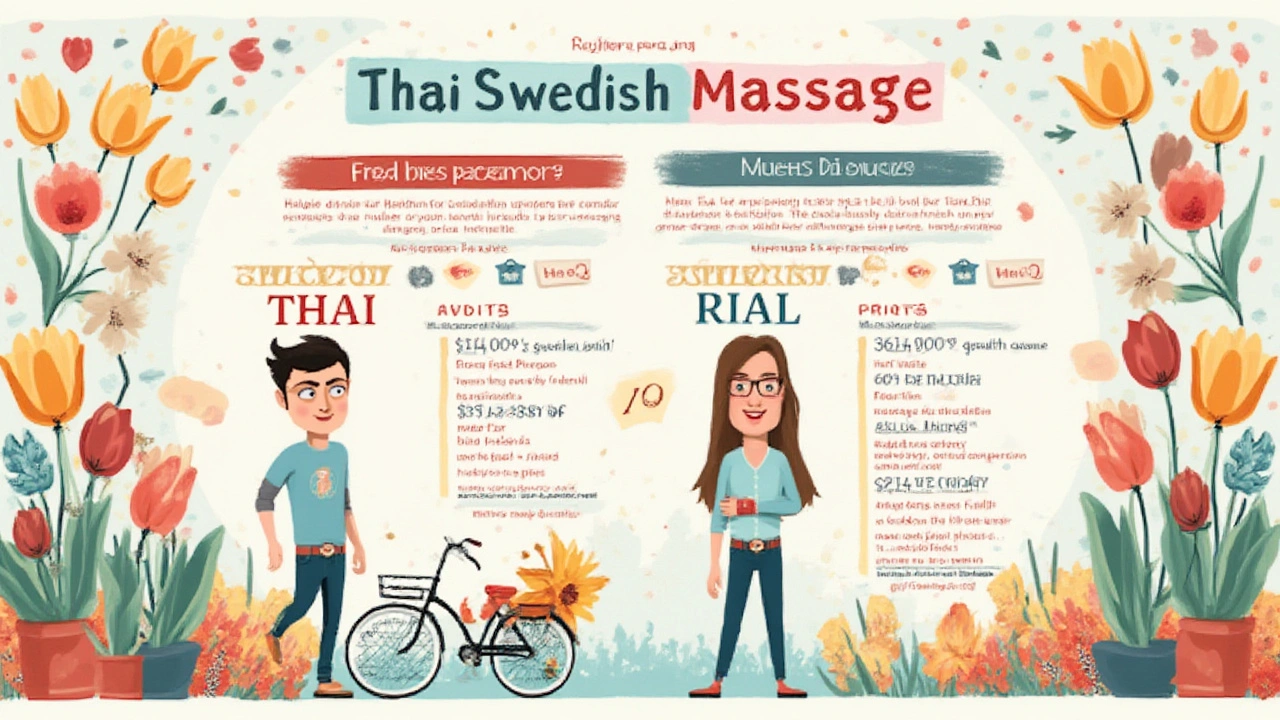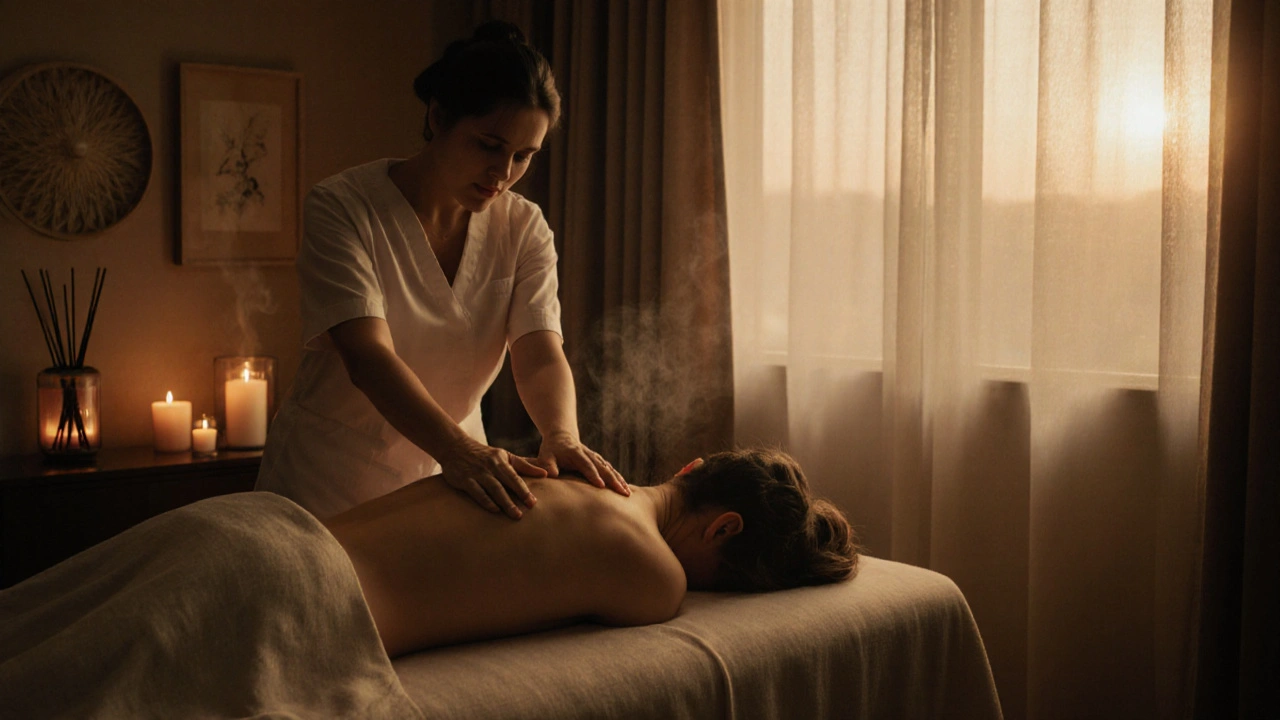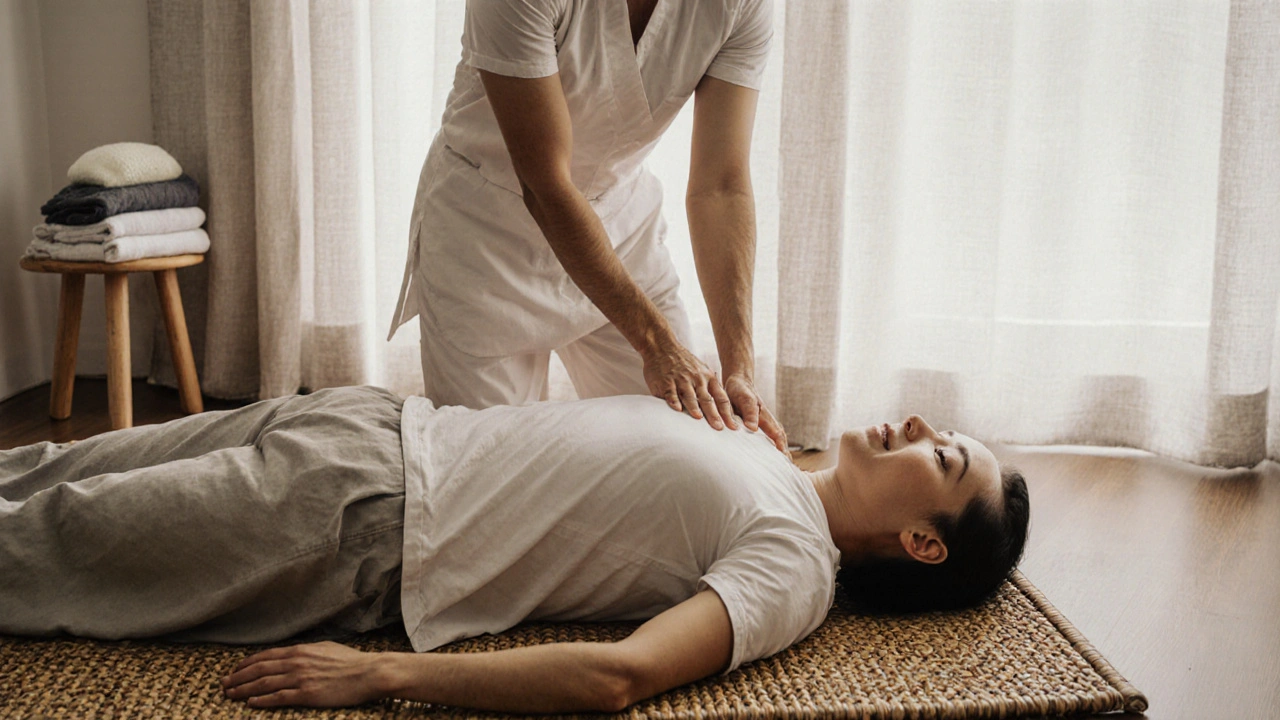Thai Massage vs. Swedish Massage: Which Massage Style Suits You Best?

Ever craved a massage but got totally lost in the spa menu? That moment you’re torn between Thai and Swedish—two giants in the world of relaxation—can feel like picking between your favorite desserts. Spoiler: they’re super different. Let’s map out what sets these massages apart, get rid of the confusion, and land you on the best massage table for your body and mind.
Defining Thai and Swedish Massage: What Makes Them Stand Out
Imagine you walk into a massage room in Bangkok—low lights, a gentle gong in the distance, and a mat on the floor, not a table. Welcome to Thai massage! This ancient style dates back over 2,500 years and blends acupressure, assisted yoga stretching, and rhythmic compression. Traditionally, you keep your clothes on (yep, no stripping) and your massage therapist becomes part yoga teacher, gently guiding your body through stretches you didn’t know were possible.
Swedish massage comes from a totally different angle. Developed in 19th-century Sweden by Per Henrik Ling, it’s what most Westerners picture with the term “massage.” Think cozy table, soft sheets, and soothing lotions or oils. The therapist uses long, flowing strokes plus kneading to melt away tension. Swedish is about calm, with moves designed to relax muscles and boost circulation. It’s less workout, more deep snooze.
Why does the style you choose even matter? Because what you want—energetic invigoration or blessed relaxation—will totally change your experience. Thai massage is like yoga minus the work. Swedish is a hug for your nervous system.
Both massage styles have their roots in healing. Thai massage is steeped in Ayurveda and Buddhist medicine. Swedish is anchored in Western anatomy and physiology. Fascinatingly, a 2023 study in the European Journal of Integrative Medicine found that regular Thai massage improved flexibility and reduced chronic pain after just four sessions. And here’s an eye-opener: Swedish massage remains the most requested style in North American spas, according to the American Massage Therapy Association’s 2024 report.
Sometimes, you’ll see “Thai-Swedish fusion” on the spa menu. This blends classic Swedish strokes with selective Thai stretches—sort of like putting peanut butter on your dark chocolate. Try both, then decide if the hybrid is for you.
The Benefits: What Each Massage Really Does for You
Let’s talk results. People love Swedish massage for deep calm, muscle relief, and a more chill nervous system. It’s incredible for folks with desk jobs, stress-induced knots, or chronic headaches. Those gentle, gliding strokes help increase blood flow, flush out lactic acid, and even give your immune system a kick. According to a 2022 Mayo Clinic review, Swedish massage reduced anxiety and depression levels significantly—especially when part of a wellness routine.
The oil or lotion used during Swedish massage isn’t just for show—it lets the therapist glide smoothly. Plus, it can really nourish your skin. Those with dry or sensitive skin often rave about the radiance they see after a session. And if it’s your first-ever massage, Swedish is less intimidating. No body bending, no surprises—just bliss.
Thai massage, in contrast, wakes up your body. If you slouch, sit too much, or feel generally stiff, this is like pressing a reset button. The stretching and compression don’t just lengthen tight muscles; they also boost joint mobility and realign posture. Real talk: you might hear some creaks and cracks—but in the best way.
Here’s a fun fact: A study published in the Journal of Bodywork & Movement Therapies in late 2023 showed that Thai massage improved flexibility in athletes even more than standard stretching. That’s why you’ll spot marathon runners and dancers booking regular Thai sessions during show season.
Both Thai and Swedish massages lower cortisol (that stress hormone everyone loves to hate) and support mental clarity. But if you’re looking to leave the room floating on air, Swedish is your ticket. Want to feel lighter, taller, and more mobile? Think Thai.
“Massage is more than a luxury; it’s a path to better physical and emotional health,” said Dr. Anna K. Lee, integrative medicine specialist, in a recent interview with Healthline.
Ever noticed how you sleep better after a massage? That’s not your imagination. Both techniques help release serotonin, so you spend less time tossing and more time dreaming.
- If you prefer a gentle, nurturing touch, Swedish is the winner.
- If you want a full-body tune-up—and don’t mind being stretched like a pretzel—give Thai a try.
- On a time crunch? A Swedish massage can be as short as 30 minutes. Thai sessions are usually at least an hour, with some traditional treatments stretching up to two hours.
- Swedish is more likely to be covered by health insurance plans, especially if prescribed by a doctor for pain or injury.

Types of Massage Services and How to Pick the Right Spot
The world of massage is like a global passport. You can find authentic Thai massage places even in small towns nowadays—and Swedish massage has gone totally mainstream. In most cities, spas, athletic clubs, and boutique wellness centers offer both. Want to experience Thai the traditional way? Look for places with floor mats instead of massage tables. Many Thai spas also burn lemongrass incense and play gentle temple music to set the scene.
Not all Thai massages are the same. There’s “Royal Thai,” super gentle and done with a formal style, and “Traditional Thai,” usually more vigorous. Some spas offer oil-based Thai massage, which is a bit closer to Swedish. As for Swedish, you might spot variations like “deep tissue” (harder pressure) or “aromatherapy” (with essential oils).
Here’s a cheat sheet for spa-hunting:
- Check out the therapist’s certifications—Thai massage schools in Thailand are world renowned, while Swedish-trained therapists are often registered with national boards.
- Read reviews. People are pretty frank online about their spa wins and horror stories.
- Ask if you can customize the session. Some places let you combine elements of Thai and Swedish to create your dream treatment.
- For locals: big cities like New York, LA, London, and Sydney have clusters of authentic Thai spas near Chinatowns or tourist districts. Swedish massage is available everywhere, even in hotel spas and salons.
And for the germ-conscious (hey, it’s 2025), ask about their cleaning protocols. Most reputable places now post sanitation details right on their websites.
What a Session Is Actually Like—Plus Costs, Safety, and More
Curious what really happens during a Thai or Swedish massage? For Swedish, undress to your comfort level (most go down to underwear, covered with a sheet). The therapist uses oil or lotion, then starts with long, even strokes. Expect some kneading, gentle percussion, and maybe circular motions. You can totally chat or just close your eyes and drift. And if you want more or less pressure, just say so—this is your time.
Thai massage is way more interactive. You’ll wear loose clothing and lie on a padded mat. The therapist might press, pull, and fold your limbs into stretches—don’t worry, you’re not expected to be flexible. Breathing helps! Some moves might surprise you (like walking along your back), but it shouldn’t hurt—good Thai therapists check in often.
First-timer tip: Eat light before your session and arrive early to fill out any forms and relax. And always drink water afterward to flush out released toxins.
About money: Swedish massage rates usually start around $75 per hour in the US, with prices in big cities topping $150+ for top-tier spas. Thai massage can be a touch less expensive, especially when booked at dedicated Thai parlors, but luxury hotel spas might charge more. Consider these sample prices:
| Massage Type | Average Cost (USD, 1 hour) | Common Locations | Typical Session Length |
|---|---|---|---|
| Thai massage | $60–$120 | Thai spas, wellness centers | 60–120 minutes |
| Swedish massage | $75–$150 | Spas, hotel spas, salons | 30–90 minutes |
Down to booking: Call ahead or use the online scheduler—most places offer both. Tip your therapist 15–20% if you’re in North America. And don’t be shy about asking if you can request a specific gender therapist or if you have health concerns.
Safety first! If you have health issues (pregnancy, osteoporosis, recent surgeries) or strong allergies, let them know upfront. Thai massage isn’t right after major surgery or for severe mobility issues. Swedish can be adapted for nearly everyone. In either case, massages should never be painful—communicate, always!
| Feature | Thai Massage | Swedish Massage |
|---|---|---|
| Main Focus | Stretching, flexibility, energy balance | Relaxation, circulation, muscle tension relief |
| Technique | Clothes on, mat-based, uses body weight | Undressed, oil-based, table massage |
| Pressure | Medium to strong, dynamic | Light to firm, usually gentle |
| Best For | Stiffness, low energy, athletes | Stress relief, beginners, chronic tension |
| Session Length | 60–120 minutes | 30–90 minutes |
| Locations | Thai spas, specialty clinics | Spas, hotels, wellness chains |
| Average Cost | $60–$120 | $75–$150 |
Still undecided? Try both and see what your body craves. Some days, you may want to stretch it out like a yogi, while others, you’ll want to melt into dreamy relaxation. The best part—there’s no wrong answer here.

FAQ: Your Thai vs. Swedish Massage Questions—Answered
- Will Thai massage hurt? No, it shouldn’t. If you feel pain, ask the therapist to stop or ease off. The stretching can be intense but is meant to feel relieving and energizing, not painful.
- Can I ask for less or more pressure? Absolutely. With Swedish massage, therapists expect you to share your preferences. Same for Thai, though they might guide how much you can do safely.
- Do I need to be flexible for Thai massage? Not at all. Your therapist adjusts to your body type and range of motion. You’re supported every step of the way.
- Is either massage type good for injuries? Swedish is gentler for healing tissue, but always let your therapist know about injuries. Thai massage can help with some chronic stiffness issues, but not for fresh injuries or post-surgery unless your doctor says it’s safe.
- How often should I get a massage? If you’re dealing with pain or stress, once a week can work wonders. For basic wellness, once a month keeps most people happy and limber.
- Which style is better for mental health? Both help by reducing anxiety and improving sleep. Swedish massage’s gentle touch is especially calming, while Thai’s energizing moves boost mood and focus.
Ready to gift your body (and your brain) some real TLC? Grab a spot at a trusted spa, and see which massage style fits your mood. The only regret? Not doing it sooner.


